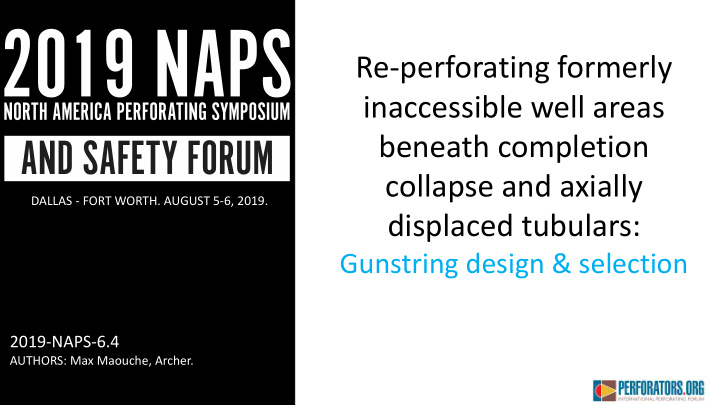



Re‐perforating formerly inaccessible well areas beneath completion collapse and axially DALLAS - FORT WORTH. AUGUST 5-6, 2019. displaced tubulars: Gunstring design & selection 2019-NAPS-6.4 AUTHORS: Max Maouche, Archer.
Re-Perforating beneath axially displaced tubulars Agenda Background Tubular Axial Displacement type and shape Flexible Perforating system requirement & design Pre-Operation Flexible Perforating system test Flexible Perforating system selection system selection Conclusion 2019-NAPS-6.4 Re‐perforating formerly inaccessible well areas beneath completion collapse and axially displaced tubulars
Background Subsidence and Geoformation impact on downhole tubulars Some of the most famous Norwegian Field have been suffering from formation faulting or compaction. North-Sea chalk pore pressure dropping lead to subsidence in many fields 1987 “Great Jack - Up” Operation lifted 6 meters, 5 out of 7 platforms Localized formation movement due to intensive reservoir treatment 2019-NAPS-6.4 Re‐perforating formerly inaccessible well areas beneath completion collapse and axially displaced tubulars
Tubular Axial Displacement 2 Main types of axially displaced completion 2019-NAPS-6.4 Re‐perforating formerly inaccessible well areas beneath completion collapse and axially displaced tubulars
Tubular Axial Displacement 2 Main types of axially displaced completion 2019-NAPS-6.4 Re‐perforating formerly inaccessible well areas beneath completion collapse and axially displaced tubulars
Flexible Perforating system design Prerequisite for Perforating System As Slim as possible Highly Flexible and easily interchangeable offshore Multiple intervals should be perforated in one run Minimum exit hole diameter of 0.18 inch through expectionally thick liner ( wall thickness ˃ 1.1”) Target : 6 5/8” Liner #65.8lbs/ft _ ID:4,375 ” Orientation of perforated holes to be at 6 o’clock . All perforating guns and accessories should be easily interchangeable offshore to ease gunstring selection Quickly available for Offshore Operation 2019-NAPS-6.4 Re‐perforating formerly inaccessible well areas beneath completion collapse and axially displaced tubulars
Flexible Perforating system design Selected Single and Multishot Perforating solutions Maximum Outer Diameter : 2 inch Single-Shot or Multi-Shot guns Reduced gun length Integrated addressable firing system Self-Orienting Guns to minimize perforating accessories. Charges selected exit holes exceeded the requirements through the heavy 6 5/8” Liner (#65.8lbs/ft) Bolted Gun system to increase flexible capacity All feed-through subsystems compatible and interchangeable : Knuckle Joint, Rotating Swivel, Variball Roller,eccentralizer,etc … Alignment tested and verified. 2019-NAPS-6.4 Re‐perforating formerly inaccessible well areas beneath completion collapse and axially displaced tubulars
Pre-Operation Flexible Perforating system test 3D modelling data sets from S-shaped collapses Thermal process of polymer shaping to recreate axial displacement measured downhole. Transparent matrix material to facilitate understanding Gunstring behaviour. Identical Internal Diameter as tubular target Flanged short tubular section to create an interchangeable interlocking set up. 2019-NAPS-6.4 Re‐perforating formerly inaccessible well areas beneath completion collapse and axially displaced tubulars
Pre-Operation Flexible Perforating system test 3D modelling a data set from a C-shaped collapse Background Tubular Axial Displacement Flexible Perforating system design Pre-Operation Flexible Perforating system test Conclusion 2019-NAPS-6.4 Re‐perforating formerly inaccessible well areas beneath completion collapse and axially displaced tubulars
Pre-Operation Flexible Perforating system test Single Shot Mono Carrier through C-shape displacement Insert VIDEO 2019-NAPS-6.4 Re‐perforating formerly inaccessible well areas beneath completion collapse and axially displaced tubulars
Pre-Operation Flexible Perforating system test Single Shot Mono Carrier through S-shape displacement Insert VIDEO 2019-NAPS-6.4 Re‐perforating formerly inaccessible well areas beneath completion collapse and axially displaced tubulars
Pre-Operation Flexible Perforating system test Single Shot Dual Carrier through C-shape displacement Insert VIDEO 2019-NAPS-6.4 Re‐perforating formerly inaccessible well areas beneath completion collapse and axially displaced tubulars
Flexible Perforating system selection Gunstring selection for Wireline and electrical Carbon Rod/Coiled Tubing Primary factor : Flexi-Point to Flexi-Point distance Secondary factor : Maximum Gun String OD Wireline conveyed : 60% of Total Gunstring weight should be located on the lower part of it. Carbon Rod conveyed : uniform spread of articulated points to avoid «push and lock» situation Depending on conveyance review Knuckle Joint design 2019-NAPS-6.4 Re‐perforating formerly inaccessible well areas beneath completion collapse and axially displaced tubulars
Conclusion Maximizing success rate of re-perforation beneath axial displacement Collecting Well Completion, Geological and field history information Identifying through study or pre-perforation investigation runs the type and shape of the deformed area Reducing Maximum Flexi-Point to Flexi-Point distance Reducing Gunstring OD Recommended use of Addressable firing system For Electrical Wire conveyance the gunstring should be “bottom heavy” For Carbon Rod/Coiled Tubing conveyance, Rollers and articulated subsystem should be spreading along the gunstring to avoid both early buckling and “push and lock” Pre-Operation system test and review of Gunstring movement and behaviour 2019-NAPS-6.4 Re‐perforating formerly inaccessible well areas beneath completion collapse and axially displaced tubulars
QUESTIONS? DALLAS - FORT WORTH. AUGUST 5-6, 2019. THANK YOU 2019-NAPS-6.4 AUTHORS: Max Maouche, Archer.
Recommend
More recommend